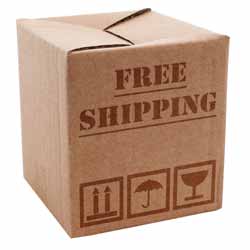 By Rob Martinez
By Rob Martinez
If you are not offering some type of free shipping today, research shows that you’re losing sales, customer loyalty, revenue per sale and product margin. In a recent Harris Poll, 66 percent of online shoppers named shipping costs as their biggest web shopping pet peeve, far ahead of the next biggest complaint (getting something that looks nothing like it did online, 38 percent). 81 percent said free shipping would make them more likely to shop online than in a store.
Additionally, 85 percent of online buyers in a National Retail Federation study preferred free standard shipping out of the five most popular promotions when shopping online. In fact, “free shipping” was chosen 166 percent more than the next best promotion. Boston Consulting Group found that shoppers actually want free shipping more than they want lower prices on the products they are buying. Forrester Research reported the number one reason for cart abandonment is the buyer’s perception that shipping costs are too high. Other research shows that 20 percent of consumers cite free shipping as the single most important factor in where they shop online, and 19 percent say they’ll pay full price for an item if free shipping is offered (www.freeshipping.org). A 2014 comScore study showed that 58 percent of shoppers will actually add items to their cart to qualify for free shipping.
Shipping costs eat away at profits, but rather than avoid free shipping, leading online sellers employ multiple strategies to keep shipping costs as low as possible. Here’s how you can, too:
1. Deferred Only.
Offer free delivery only for lower cost deferred shipping services. 85 percent of shoppers are willing to wait 5 days for an online order, and if free shipping is offered, 83 percent are satisfied with 7-day delivery. FedEx SmartPost, UPS SurePost, UPS Mail Innovations, Newgistics, DHL Global Mail and OSM Worldwide are some of the larger postal consolidators that offer two-seven day delivery to the residence at significantly lower pricing than Air and Ground services.
2. Go Postal.
Shippers that add the US Postal Service (USPS) to their carrier mix can significantly drive down costs and improve service. The USPS enjoys many unique advantages over private carriers. They already go to every door, every day. Other carriers often need to make an additional stop, especially to residences. Many USPS products are competitively priced, especially when compared with fully landed costs, with special handling and surcharges included, with UPS and FedEx. Rates are offered at several pricing options: Retail, Commercial Base, Commercial Plus and custom Negotiated Services Agreements (NSA). There are also many flat, unlimited weight and Regional Rate options.
A pricing analysis reveals that the USPS is particularly competitive for lightweight, residential packages, especially to close-in zones. It’s a low cost choice for offshore shipments to AK/HI, as well as US Territories. It offers free packaging, free pickups, and free Saturday delivery. It is the only carrier that offers First Class pricing for parcels that weigh under a pound, with delivery service standards within 1-3 business days.
3. Ship-to-Store.
Shipping consolidated packages to a single location is significantly cheaper than shipping individual, lightweight packages to multiple residences. Here’s how ship-to-store strategies work: The customer makes a purchase on the retailer’s website and chooses to pick up their order in-store; the retail location is notified of the incoming order, and fulfills it using in-store inventory. Alternatively, if an item is unavailable at the local store, it can be shipped directly from a distribution center, another store, or even a vendor location. Lastly, the customer picks up the item at their convenience.
 And it’s another great way to increase order value. In a study of Shop-a-Tron merchants, once in a store, more than 40 percent of in-store pickup orders resulted in additional sales. According to Forbes, in-store pickup is emerging as one of the most prominent ways to blend the online and offline shopping experiences. More and more retailers are beginning to launch in-store pickup programs as a way to boost sales and increase online conversions: 70 percent of the top 10 retailers offer in-store pickup of online orders. However, only about one quarter of the remaining 30 percent provide the same option.
And it’s another great way to increase order value. In a study of Shop-a-Tron merchants, once in a store, more than 40 percent of in-store pickup orders resulted in additional sales. According to Forbes, in-store pickup is emerging as one of the most prominent ways to blend the online and offline shopping experiences. More and more retailers are beginning to launch in-store pickup programs as a way to boost sales and increase online conversions: 70 percent of the top 10 retailers offer in-store pickup of online orders. However, only about one quarter of the remaining 30 percent provide the same option.
4. Build into Product Cost.
Remember the BCG study that found shoppers want free shipping more than they want lower prices on the products they are buying. Simply build shipping charges into the product cost for certain items. Let’s say the target product price at desired margins is $90. Sell it at $95 and include free shipping. Companies like Zappos are able to collect close to 100 percent margins in an extremely competitive, and in many cases, low margin shoe industry, in part by offering free shipping & returns.
5. Limited Products.
Advertise free shipping, promote free shipping, and do free shipping, but limit it to those products that make the most economic sense. Do not offer free shipping on items for which you’ll incur dimensional or oversize charges, assembly costs, high insurance fees, or other extraordinary costs. Conversely, offer free shipping only on higher margin products that can absorb the additional shipping expense. According to Baird Equity Research, only about 10 percent of Amazon’s physical items are available for Prime.
Still feel you can’t afford to offer free shipping? Look for part two in the December issue, for more strategies to offer free shipping.
